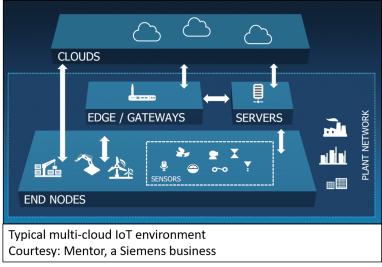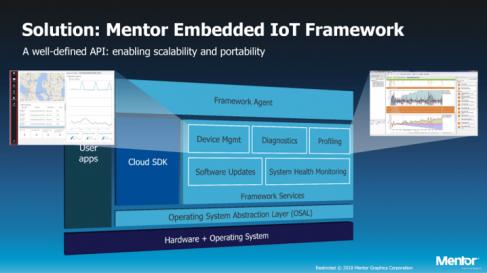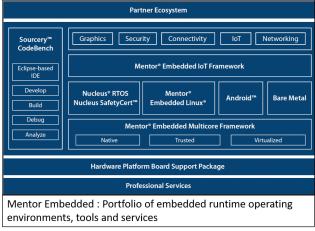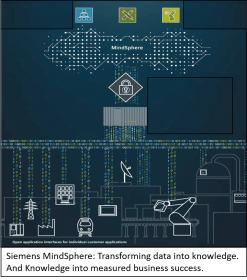For those of you who wondered at the logic behind Siemens acquisition of Mentor Graphics last year, look no further than a recent announcement by Mentor, now a Siemens business, regarding the release of their new Mentor Embedded IoT Framework (MEIF). To help connect the dots, we need to back up a bit and review a few things about how the IoT and Industry 4.0 works.

Since we are primarily concerned with ICs, we note that as part of the Industry 4.0, sensors, actuators, micro-controllers and sometimes multi-core SoCs are being added to industrial equipment to better enable management and control of industrial processes. The basic premise is that IoT edge devices are co-located with industrial equipment. Those devices monitor industrial processes and then send data to IoT gateways for data fusion and some processing. Eventually the data is then sent to the IoT Cloud for further processing.
In reality, it’s much more complex than that. IoT systems typically are made up of many Clouds and many edge and gateway devices from different providers that must talk to each other. Back-end processing in the cloud is usually handled by service providers such as Amazon, Microsoft and surprise, Siemens!
We typically think of Cloud companies providing services for things like data storage, data analytics, and transforming data into actionable business intelligence. However, cloud providers also have services to help manage IoT devices, including monitoring of device health, security, and providing for over-the-air software updates for devices with embedded software. This is usually done through a set of application programming interface (API) calls supplied by a software developer’s kit (SDK) that is unique to the cloud provider. The SDK and APIs help to massage data from edge and gateway devices into a form that can be used by the Cloud providers IoT operating system and data analysis applications.

Now let’s connect a couple more dots. For sophisticated SoCs at the gateway (and sometimes edge) devices, there will be embedded software that must deal with not one SDK but multiple SDKs from multiple cloud vendors. This is where Mentor’s MEIF product comes in. It acts as a standard software switch box that enables the embedded software provider to be able to write their software using one set of libraries, routines and API calls, regardless of the operating system or hardware it is running on, and regardless of the number of different cloud SDKs to which it must talk.
Some of the key attributes of Mentor’s Embedded IoT Framework are that it is:
- scalable from micro-controllers up to large multi-core SoCs
- portable across operating systems including Mentor’s own Embedded Linux and Nucleus RTOS
- portable across hardware architectures like ARM and X86
- extensible and customizable
- has infrastructure and tools to enable IoT security
- support multi-cloud environments

MEIF maps embedded software calls in edge and gateway devices to Cloud-provider specific API calls from Amazon Web Services (AWS), Eclipse IoT, Microsoft Azure, and Siemens MindSphere. It also adds code that takes care of a breadth of services that enables backend communications and applications including: device authentication and provisioning; configuration and control; monitoring and diagnostics; and software updates and maintenance. Mentor’s framework is open and customizable for industrial customers who want scalable and portable solutions for multi-cloud environments.
MEIF also supports features to help manufacturers manage reliability, uptime, and overall quality by using Smart Device information to report device utilization, do system profiling and to provide support for alarms and events, all of which are key value propositions for using Industry 4.0.

MEIF incorporates Mentor’s Embedded runtime platforms which provide for hardware-based root-of-trust and software chain-of-trust security both during runtime and during device boot-up. This also includes support for secure data transfers both up to the cloud and down to the devices on the manufacturing floor.
So, to complete the picture, when large companies make acquisitions, such as was done by Siemens with Mentor, you need to first look at the adjacencies. It’s clear in this case that Siemens has a large interest in the IoT Cloud infrastructure with their MindSphere family of products. Potential business is huge, but it could be bigger if they could make it easier for IoT edge and gateway device suppliers to be able to use MindSphere with other cloud providers. Mentor’s embedded systems group was a key enabler to doing just that.
While it may not be the only reason Siemens acquired Mentor, it certainly looks like one of the good ones. It makes a lot of sense and it’s good to see Siemens leveraging their Mentor investment back into their other products and services.
See Also:
Press release – Mentor advanced Industry 4.0 for Smart, Connected Devices
Data sheet – Mentor Embedded IoT Framework
Siemens MindSphere






Comments
There are no comments yet.
You must register or log in to view/post comments.